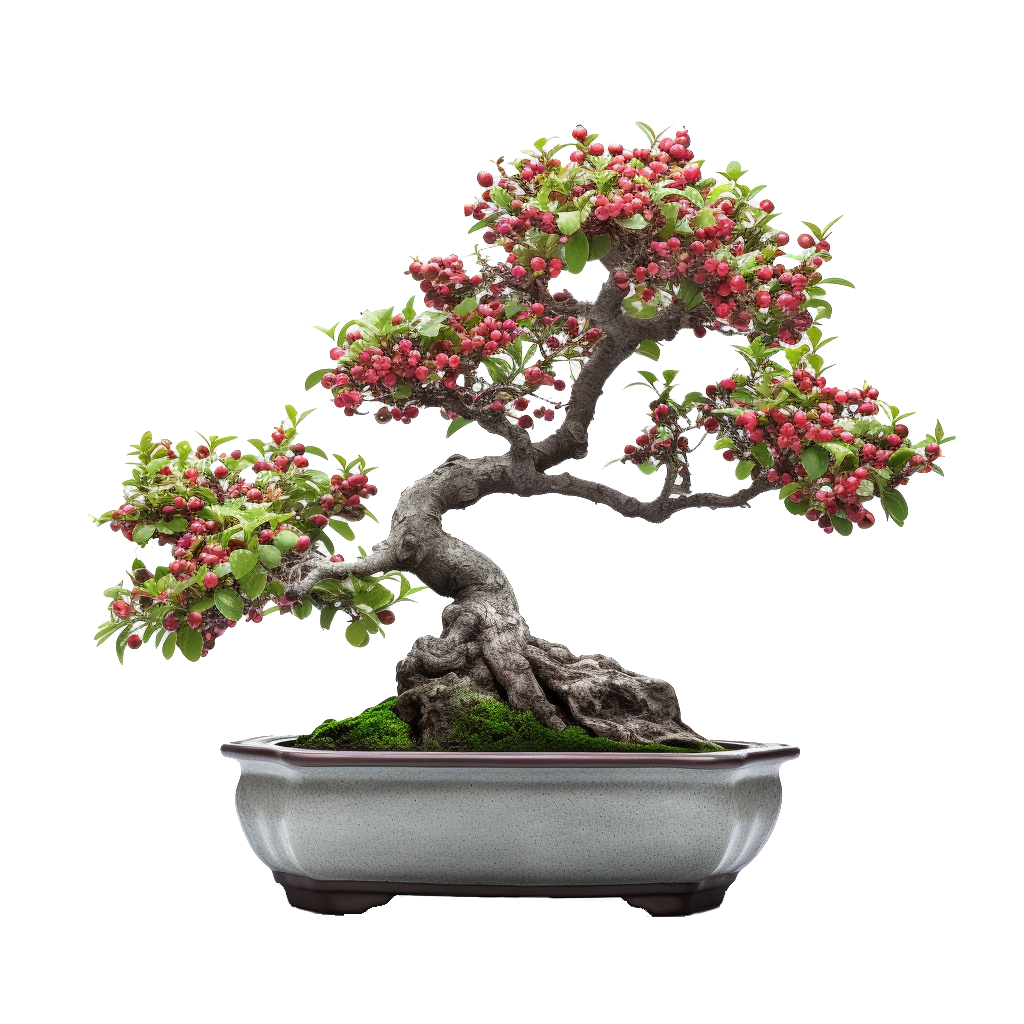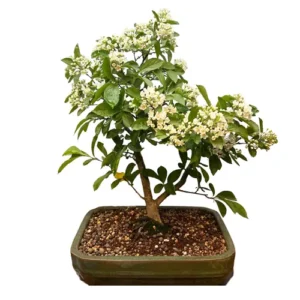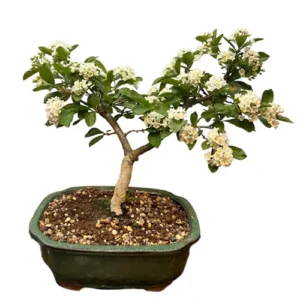Cotoneaster Horizontalis
Cotoneaster Bonsai
Cotoneasters are native to Europe, North Africa and Asia and can tolerate most climates. They are known for their vigorous growth and make an attractive bonsai tree that flowers white in spring and produces tiny red berries in autumn.

Cotoneaster Bonsai Care Tips
Placement
The cotoneaster is a very hardy species that can tolerate harsh conditions well and should be kept outdoors. Look for a spot that receives bright and full sun, your cotoneaster will not survive indoors.
Action does not necessarily need to be taken during the winter as these species require a cooler period of about three months and can withstand some freezing temperatures. Even though in nature they are generally found in cold temperate climates, when planted in a small pot for bonsai, the roots are at risk of freezing. We recommend protecting your tree from frost and strong winds. Consider using a cold frame or bringing it indoors to an unheated space such as a greenhouse to more safely allow for its dormancy period.
Watering
There is no definitive guide to watering and it should be conducted on an observational schedule, not a routine. This means that it is important to keep an eye on the moisture levels of the soil to avoid over and under watering, both which can lead to dropping leaves and/or root death. The amount of water a bonsai requires depends on pot size, climate, airflow, soil and tree type so it is best to use your eyes and fingers to assess whether the soil is damp, wet or dry.
If the top inch or so of soil has dried, it is ready to be watered. When you water, try to get an even coverage over the roots and soil, allowing water to flow out from the bottom of the pot to ensure a good soaking.
If you are a first-time bonsai owner, another way to water is by submerging the entire pot in water until the bubbles stop. If you choose this method, be aware that your bonsai may not need watering for another two to four days, but this will depend on the factors mentioned above such as soil type, pot size and climate.
The cotoneaster will need plenty of water during the hot summer months but is slightly different from other bonsai species in that it can survive some days without. During winter, just keep the roots slightly moist.
Feeding & Fertilising
Using fertiliser on your cotoneaster will help encourage healthy growth and this should be done periodically from once a week to every two months and only during the growing season. You can start adding Chrysal Liquid Bonsai Feed to your water from March until October and use weekly. Use Naruko Fertiliser Slow-Release Bonsai Feed once every one to two months. With Buddhist Pine trees, less is more, and we tend to advise using half the recommended dosage to see how your Buddhist Pine reacts first.
Pruning & Wiring
Pruning your bonsai is important not only to maintain or create an aesthetic style but to also ensure light and airflow can reach inner leaves and the cotoneaster tolerates aggressive pruning well. You can trim new growth throughout the year, but best to leave chopping older branches until spring. A thick canopy with lots of small branches and leaves (ramification) is a desirable look on a cotoneaster bonsai tree and this can be achieved by trimming the branches, which encourages new growth in different directions. You can also do this in the summer growing season to encourage back budding. Cut off lower branches to encourage more top growth as well as branches that obscure the main part of the trunk. If your bonsai is small or young, it is good practice to trim the stems that are growing straight up and long, to re-direct the tree’s energy away from lanky and thin upward trunk growth and encourage finer branching.
Training your cotoneaster using wiring can be done at any time of the year. Cotoneaster bonsai trees have naturally cascading branches, so wiring is often used to create a more upright appearance. The younger branches can be manipulated easily, but the older ones are more prone to snapping if bending them heavily. Be aware that the bark is susceptible to scarring and doesn’t heal as well as some other species. We recommend using wires with a thickness that matches the thickness of the branch: if the wire you choose is too thick you will damage the bark. If it is too thin, it won’t be effective.
Repotting
Repotting your tree is an important way to provide a fresh and suitable soil mix and ensure appropriate root health. Repot in early spring. Generally, your cotoneaster will need to be re-potted every year if it is young and older ones can stay in their pots for longer. However, you should always check if it has become root-bound before you change pots. You can do this by lifting the tree gently out of the pot by the main trunk and examining the root system. You will know it is ready if you can see that the roots are circling around each other and the pot. If, however, they still appear contained in the soil, you should place it back and wait until the following spring to check again.
Trees that are ready for repotting will require root pruning, a suitable new pot and appropriate soil mix.
When repotting, do not cut back the root mass by a large amount, and choose a well-draining soil mix that has a neutral or slightly higher PH value of 5-6 but not over 7. We tend to use a mixture of different speciality bonsai soils on our trees. Every species is different so please contact us for free soil-mix advice or to take advantage of our repotting service.
Bonsai trees aren’t only magnificent additions to an indoor oasis, they are more than capable of standing out in any garden. Many Bonsai species are incredibly hardy and withstand nature’s colder and damper turns with aplomb making them worthwhile outdoor plants. We have an extensive library of care guides for outdoor bonsai trees. It’s not about selecting the perfect bonsai, it’s about selecting the perfect bonsai for you.
Cotoneaster Bonsai - Typical Queries
How to propagate my Cotoneaster Bonsai?
You can propagate your Cotoneaster Bonsai by seeds, cuttings, or layering. Seeds can be sown in autumn or spring, but they may take a long time to germinate and grow. Cuttings can be taken in summer, from semi-hardwood stems with several leaves. Cut the stem at a 45-degree angle and dip the end in rooting hormone. Then, insert the cutting in a moist soil mix and keep it in a warm and humid place. Layering can be done in spring or summer, by bending a low branch and burying a part of it in the soil. After a few months, the branch will develop roots and can be separated from the parent plant.
How to deal with pests and diseases on my Cotoneaster Bonsai?
Pests and diseases can affect the health and appearance of your Cotoneaster Bonsai. Some of the common pests and diseases that may attack your Cotoneaster Bonsai are aphids, scale insects, spider mites, fire blight, leaf spot, and powdery mildew. To prevent and treat pests and diseases, you should keep your Cotoneaster Bonsai in good condition, inspect it regularly, and use appropriate pesticides or fungicides if needed. You can also use natural remedies, such as neem oil, soap spray, or vinegar spray, to control pests and diseases.
Can I keep my Cotoneaster Bonsai indoors?
Cotoneaster Bonsai is best suited for outdoor cultivation, as it needs plenty of sunlight and air circulation. However, you can keep your Cotoneaster Bonsai indoors for short periods, such as during winter or when displaying it. If you keep your Cotoneaster Bonsai indoors, you should place it near a bright window, away from direct heat or cold sources, and mist it daily to increase humidity. You should also monitor the soil moisture and water your Cotoneaster Bonsai as needed.





















